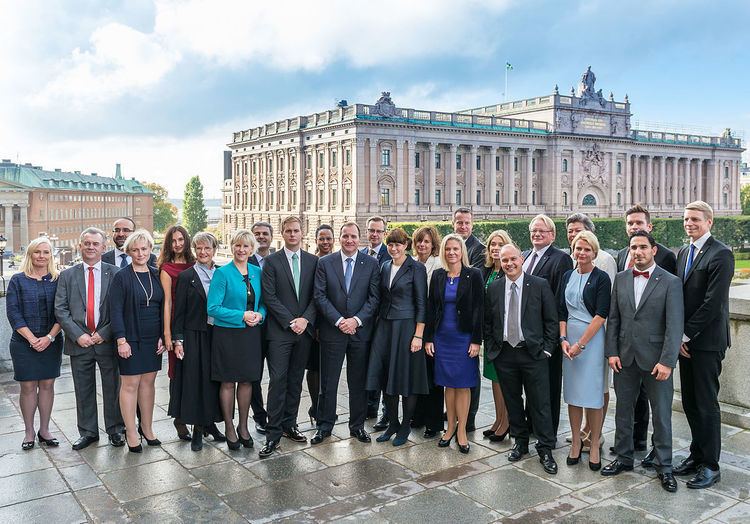Date formed 3 October 2014 Head of state Carl XVI Gustaf Ministers removed
(Death/resignation/dismissal) 4 | Head of government Stefan Löfven No. of ministers 23 | |
 | ||
Deputy head of government Margot Wallström (acting)
Isabella Lövin (honorary title)
Former:
Åsa Romson (honorary title, 2014–2016) | ||
The cabinet of Stefan Löfven is the present Government of Sweden. It is a coalition cabinet consisting of two parties: the Social Democrats and the Green Party. The cabinet was installed on 3 October 2014, following the 2014 general election.
Contents
With only 37.9% of the popular votes and roughly 39.5% of the seats in parliament (138 out of 349 seats), it is one of the weakest minority governments in Swedish history and the cabinet will need to seek support from other parties in the Swedish Riksdag; they have ruled out cooperation with the Sweden Democrats. This is the first time that the Green Party is part of a cabinet, and the first time in 57 years that the Social Democrats has formed a coalition cabinet. It is led by Prime Minister Stefan Löfven, leader of the Social Democrats. The new cabinet consists of 12 men and 12 women.
The cabinet was installed following a formal government meeting with King Carl XVI Gustaf at 12:00 AM on 3 October 2014. Stefan Löfven had previously announced his cabinet ministers at 09:00 AM on the same day.
On 25 May 2016, Prime Minister Stefan Löfven made a cabinet reshuffle.
Facts and statistics
The numbers below refer to the composition of the cabinet at its formation on October 3, 2014.
Party breakdown
Party breakdown of cabinet ministers:
December 2014 budget crisis
On 3 December 2014, the proposed budget of the Löfven Cabinet failed in the Riksdag due to the Sweden Democrats siding with the centre-right opposition Alliance's budget. Prime Minister Löfven announced plans to call for fresh elections in March 2015. However, on 27 December, the early election was cancelled after the governing parties signed an agreement with the four parties in the opposition Alliance. Under the "Decemberöverenskommelsen" (December Agreement), the six parties agreed not to vote against a budget proposed by the government for the next eight years. The December Agreement fell in October 2015 when the Christian Democrats decided to leave it.
Policy
The government has announced the outline of its policy on 3 October 2014. Plans included reducing unemployment to the lowest level in the EU by 2020, reducing deficits, phasing out nuclear energy, reducing emissions from fossil fuels and having a more socially liberal asylum policy.
In its statement the government identified as feminist. It aims to increase gender equality, reduce the gender wage gap and introduce quota if female representation on governing boards is below 40% by 2016. It also promised to increase penalties for aggravated sexual offences.
The government's foreign policy will consist of pursuing membership of the Security Council and remaining outside NATO. The government said it opposes ISIL. It was the first EU government to recognise the State of Palestine in view to "facilitate a peace agreement by making the parties less unequal", resulting in that Israel the same day recalled its ambassador for consultations.
